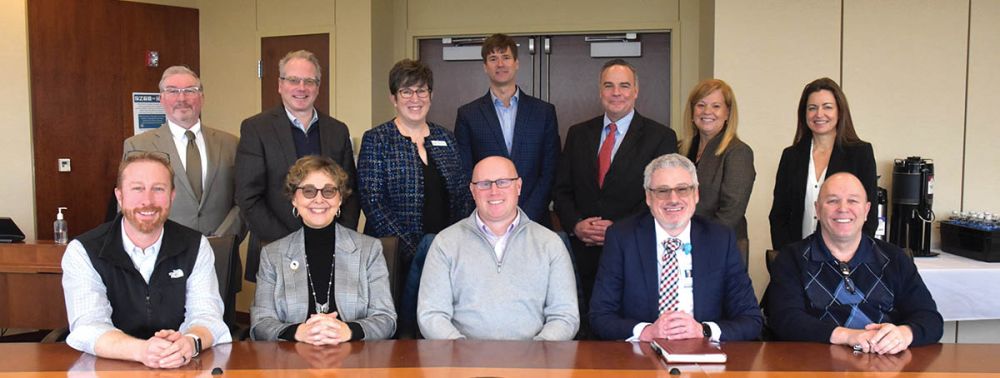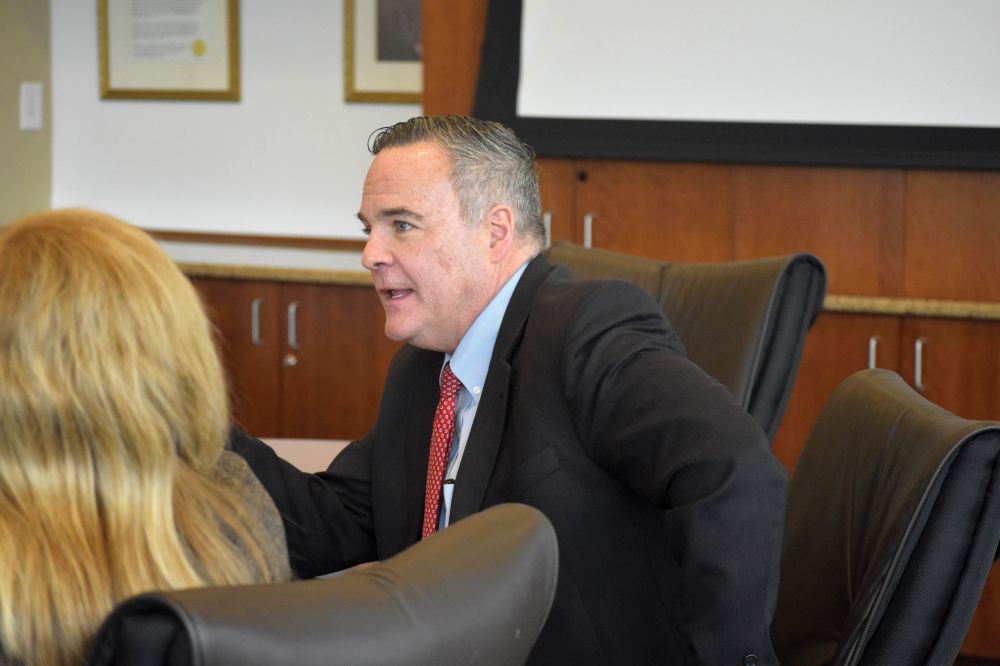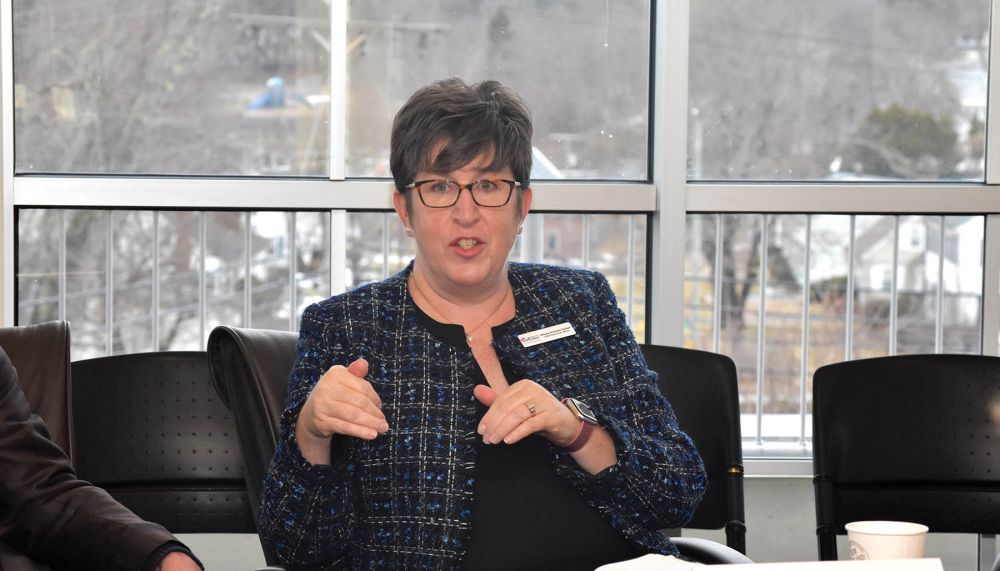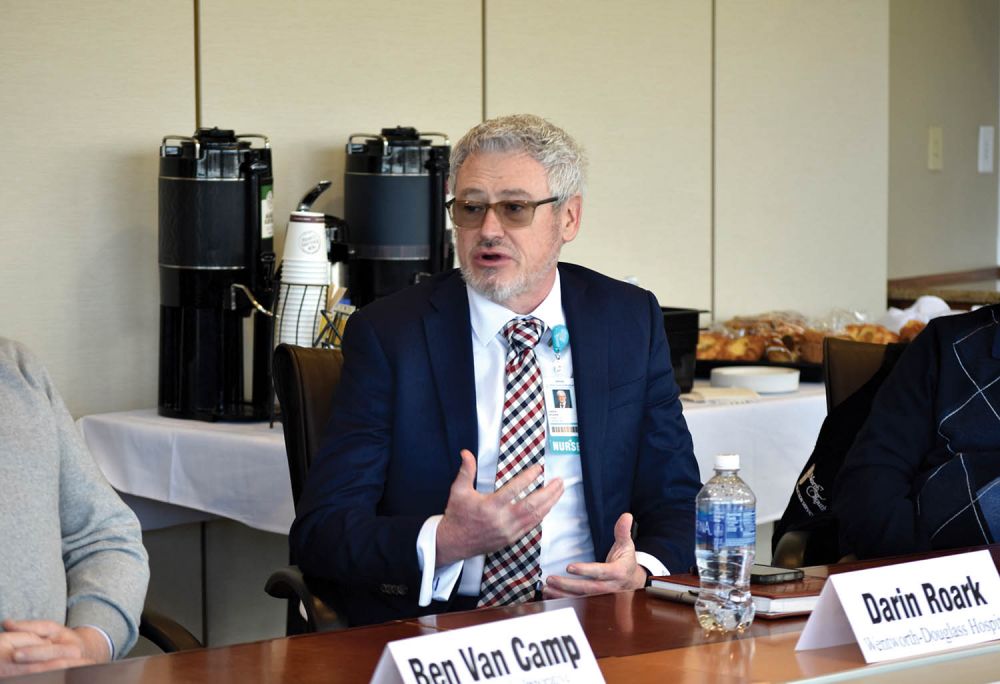
Back row from left: Dennis McCann, executive director of Strafford Economic Development Corporation; Paul Brean, executive director of Pease Development Authority; Betsey Andrews Parker, CEO of Community Action Partnership of Strafford County; Christian Stallkamp, senior broker and partner at The Boulos Company; Paul Callaghan, mayor of Rochester; Patty McGrail, senior vice president of The Leddy Group; Anne Ruozzi, owner and CEO of Therapy Clean. Front row from left: Evan Hennessey, chef and owner of Stages at One Washington; Cheryl Lesser, president of Great Bay Community College; Ben VanCamp, chief collaborator and president of The Chamber Collaborative of Greater Portsmouth; Darin Roark, president and CEO of Wentworth-Douglass Hospital; and Pete Johnson, CEO of North & South Construction Services. (Photos by Christine Carignan)
Business NH Magazine kicks off regional roundtable series
The NH Seacoast is a diverse region full of economic vibrancy and historical charm, but that charm comes with a hefty price tag. One-bedroom apartments range from $1,800 to $3,000 a month and the median sale price for homes in the region was $564,450, according to a February report from RocketHomes.com.
The Seacoast economy has more than its share of success stories. Pease International Tradeport is one of the most successful economic endeavors in the state’s history and continues to thrive. Lonza Biologics broke ground last August on a new 130,000-square-foot facility to develop Type 1 diabetes therapies with Boston-based Vertex Pharmaceuticals. Portsmouth boasts more restaurant seats than residents, and Dover and Rochester are among the fastest growing cities in the state.
Despite its prosperity, the Seacoast region has its share of challenges. Skyrocketing housing costs and lack of affordable childcare makes it difficult to attract and retain employees.
In February, a group of Seacoast community and business leaders gathered at Wentworth-Douglass Hospital in Dover to discuss challenges and solutions. The event launches a regional roundtable discussion series to be hosted throughout the year by Business NH Magazine.
 High Childcare and Housing Costs
High Childcare and Housing Costs
According to a report by the NH Fiscal Policy Institute (NHFPI), nearly half of all renter households in NH are cost-burdened, meaning they spend more than 30% of their income on rent and utilities. This translates to approximately 153,349 households in NH as of 2023.
The median monthly rent for two-bedroom units in NH was $1,764 in 2023, up 11.4% from 2022, according to the NH 2023 Residential Rent Cost Survey Report from NH Housing. Median monthly rents in Strafford and Rockingham Counties, which include the Seacoast Region, were $1,613 and $1,944 respectively, according to the NH Housing report. Those rents skyrocketed by 37% between 2022 and 2023 in Strafford County and by 34% in Rockingham County.
Each county has a Community Action Partnership (CAP) nonprofit agency, providing programs and resources tailored to the unique needs of its community, such as emergency rental assistance, Head Start programs, transportation and Meals on Wheels. Betsey Andrews Parker, CEO for the Community Action Partnership (CAP) of Strafford County, says her agency provided the second highest amount of rental assistance by CAP programs in the state during the pandemic, behind only Hillsborough County.
“I like to think my team were unicorns and rocked it out, but the fact of the matter is that rents in Strafford County went up,” she says. Landlords now require two and half times a person’s salary to rent a one-bedroom apartment, Parker says. “If you’re not making $60,000 a year, you cannot rent a one-bedroom apartment here. If you’re making $47,000 a year and paying 50% of your income in rent, a landlord will not rent to you.”
 Parker says the days when people could move further north to work in the Seacoast are gone. “When people are asking for a higher wage, that’s so they can live in [this] community,” she says. “Gone are the days of moving to Farmington, Milton, New Durham and finding affordable living.”
Parker says the days when people could move further north to work in the Seacoast are gone. “When people are asking for a higher wage, that’s so they can live in [this] community,” she says. “Gone are the days of moving to Farmington, Milton, New Durham and finding affordable living.”
Of the 949 landlords Strafford County CAP worked with through the rental assistance program during the pandemic, only 200 remain, Parker says. “If you know a landlord, help us out. We have good people in the workforce who have Section 8 vouchers who cannot stay in the community,” she says.
The high cost of housing in the Seacoast is proving challenging across the economic spectrum. Wentworth-Douglass Hospital President and CEO Darin Roark says his organization is “trying to do everything we can” to keep employees, but the lack of affordable housing makes it difficult. “Where do folks live? How do they find a place to live? Me and my wife moved here and it’s no secret we’ve struggled to find a house and I’m a hospital CEO,” he says.
Paul Brean, Pease International Tradeport’s executive director, says people sometimes ask him why affordable housing can’t be built at the Tradeport. Despite its 3,000 acres, Pease isn’t zoned for housing because it is considered an incompatible use of an airport, according to the Federal Aviation Administration, Brean says. One way Pease can help with housing, he adds, is through the construction of much needed warehouses and by supporting college campus facilities like GBCC, which alleviates land in surrounding communities. “We can contribute to the solution by taking on some of the industrial activity where land could be repurposed,” he says.
Rochester Mayor Paul Callaghan says at least 400 units have been built in his city, but more are needed. “We had a development of 92 units, and one called Apple Ridge with 104 units,” he says. “They’re energy efficient and really top notch.”
The high rents in the region have forced some employers to take matters into their own hands to attract and retain employees. Dennis McCann, executive director for the Strafford Economic Development Corporation (SEDC), points to Harmony Homes, an owner-operated assisted-living community that developed affordable housing for its employees. “[SEDC] put $1.3 million into that because a commercial lender is only going to be just so comfortable with that kind of project,” he says. “It has been immensely popular.”
Great Bay Community College President Cheryl Lesser says the college plays a role in keeping people in the Seacoast by helping to find affordable housing for students. Lesser points to a vet tech student at the college who is working for Harmony Homes and living there at a reduced rate. “That’s not someone who’s going to necessarily work at Harmony Homes but we’re also working with the owners [John and Maggy Randall] to make sure there’s a pipeline of other students and some of them will end up working for them.”
Lesser says the college’s outreach coordinator is “plugged in” to people like Parker who help people secure affordable apartments and childcare.
Childcare costs are also a burden for many people in the Seacoast. Community Action Partnership (CAP) of Strafford County—which operates four child care centers in Dover, Farmington, Rochester and Somersworth—pays its childcare workers close to $18 an hour, but Parker says that isn’t enough as CAP is competing with retail stores like Walmart for workers. “I have a $70,000 deficit for my largest childcare facility in Farmington and we’re finding a way to make that coverage up so we can keep 90 kids,” she says.
Callaghan says he recently met with a group of local manufacturers who told him childcare was second only to affordable housing as their biggest concern. “They’re saying, ‘We’re training these folks and then in a week or two, they leave because they can’t find childcare,’” he says. “And the pay isn’t enough [for childcare workers]. One childcare worker I heard about is couch surfing.”
Cost of Living Skyrockets in Portsmouth
Ben VanCamp, chief collaborator and president of The Chamber Collaborative of Greater Portsmouth, says the city experienced great economic success in recent years but it has also been the victim of that success.
“We’ve experienced the highest cost of living anywhere in the state of New Hampshire,” he says. “We have seen a dramatic drop in the availability of homes taking Section 8 vouchers.” And this is happening while developers of luxury apartments and condos eagerly wait for new properties to go up for sale. “People are selling to the highest bidder and our nonprofit housing folks cannot move fast enough to bid on [these] project[s].”
VanCamp says the Portsmouth Housing Authority’s Ruth Griffin Workforce Housing Complex next to the fire station was a success, but he agrees with Callaghan, it’s not enough. “We can celebrate those new units, but we probably lost 80 to 100 units in that same time. It’s one step forward two steps back on the housing piece for us.”
VanCamp says Portsmouth is examining ways to import the workers it needs. “We’re asking what we can do to improve transportation so that people can get to jobs in Portsmouth from Rochester and Dover and other communities around the Seacoast,” he says.
VanCamp recently testified before the NH Legislature, urging the passage of mandatory inclusive zoning, which he says could help relieve some of the affordable housing shortage. The proposed law would allow communities to create zoning districts where a percentage of new housing is required to be affordable housing. “Hopefully Portsmouth will have the ability in a year or two to require a certain percentage of units to be [affordable],” he says.
Housing Costs Put Pressure on Employers
Patty McGrail, senior vice president for the Leddy Group in Dover, a staffing company with locations throughout NH, says high living costs in the Seacoast “is definitely a pain point for our clients,” adding that over the last couple of years many of the Leddy Group’s clients focused on trying to hang on to workers.
Anne Ruozzi, owner and CEO of Therapy Clean, which manufactures plant-based cleaning products, says recent outsourcing at her company has been heartbreaking. Therapy Clean used to have 20 employees at its manufacturing facility in Somersworth but is down to three since November after outsourcing much of its manufacturing. She says the high cost of living in the area made it difficult to recruit and retain employees.
“It’s very hard to find reliable people that you can count on, and it takes time to train people. They also demand high pay,” Ruozzi says. “We are generous but for a small company, it’s really taxing.”
Ruozzi says her company made sure the employees that were laid off at Therapy Clean “landed softly and found jobs.”
“As much as we paid them handsomely for the jobs that they were doing they were still living in borderline poverty,” she says. “It’s difficult to see these people struggling. The dollar does not go far enough.”
.jpg) Evan Hennessey, chef and owner of the restaurant Stages at One Washington in Dover, says it is difficult to balance what consumers are willing to pay with the cost of food and labor costs due to the high cost of living in the area. “The dishes and drinks that we serve, you as a consumer are only willing to pay X amount of dollars for that,” Hennessey says. “As living expenses continue to go up, my cap on what I can charge … we’re basically at it.”
Evan Hennessey, chef and owner of the restaurant Stages at One Washington in Dover, says it is difficult to balance what consumers are willing to pay with the cost of food and labor costs due to the high cost of living in the area. “The dishes and drinks that we serve, you as a consumer are only willing to pay X amount of dollars for that,” Hennessey says. “As living expenses continue to go up, my cap on what I can charge … we’re basically at it.”
Hennessey says he has increased prices exponentially since the COVID pandemic. “We jumped our prices and then we jumped again and then jumped one more time,” he says, explaining that eventually he reached the limit of what the market would bear. But the cost of living kept increasing. “Living expenses of our employees just continue to go up and up and up and up,” he says. “And then I have to let somebody go in order to keep somebody.”
“I hate to put it in these terms but the person who has less value to the company, we absorb those job tasks into other departments and then we give more money to the person I need because [they’re] going to help my future,” Hennessey says.
Hennessey warns that if the cost of living continues to rise, small restaurants could close, giving way to 200 and 300 seat restaurants. “That, in my opinion, gives you the lesser quality. But their margins are higher so they can pay people,” he says. “Small businesses provide color to communities. We know your name and if that goes away, I can’t even imagine the black and white world we’re left with.”
Growing Challenges for the Healthcare Industry
The Seacoast is home to four major hospitals and is a major hub for other medical practices and health-related businesses. Wentworth-Douglass Hospital in Dover employs just over 4,500 people alone and requires a healthy pipeline of employees to meet the growing demand of NH’s
aging population.
New Hampshire Housing reports the state’s aging population will require 47% more health care and service industries workers through 2030. But retaining healthcare workers has been difficult, Roark says. “I would say it has never been a more challenging time to be a hospital leader. We’ve seen near 60% turnover in the hospital,” he says.
 Despite high turnover, Roark says he’s grateful many people remain in the field. He emphasizes the importance of maintaining the Seacoast’s workforce pipeline by working with companies like the Leddy Group and local colleges. “The worst thing we can have happen is to get students from UNH or Great Bay who get an education and can work in healthcare and decide to go to Boston or someplace else for a higher wage,” he says.
Despite high turnover, Roark says he’s grateful many people remain in the field. He emphasizes the importance of maintaining the Seacoast’s workforce pipeline by working with companies like the Leddy Group and local colleges. “The worst thing we can have happen is to get students from UNH or Great Bay who get an education and can work in healthcare and decide to go to Boston or someplace else for a higher wage,” he says.
A big challenge, Roark says, has been a 20% increase in the cost of labor. “This is very challenging for us because roughly 70% of our income comes from government payers such as Medicaid and Medicare,” he says. “I’m very thankful we’re now owned by Mass General Brigham because it gives us a bigger balance sheet. I don’t know how an independent hospital can survive in this market.”
Roark says the high costs associated with extended care and rehab facilities are another challenge. “Those places encounter the same employment challenges we do. We can’t necessarily get [patients] into an open bed someplace else so we’re forced to keep those folks here. Once [Medicare] has stopped paying us, [we’re] providing that service for free.”
Lesser says the college is increasing its workforce training programs to address the needs of the healthcare industry and other sectors. Great Bay Community College is working with the Portsmouth Naval Shipyard to create job opportunities for students in welding. “Welding is a huge area in need and one of the biggest, of course, is healthcare,” she says.
Tapping into a Diverse Community
Hispanic and Latino Americans make up 2.25% of Portsmouth’s population—the largest ethnic minority in the city, according to Neilsberg, a global market research firm. North & South Construction Services, a union company in Newington, is increasingly tapping into this demographic to meet its workforce needs.
Six years ago, CEO Pete Johnson says his firm began courting the Latino community. He says many of the company’s Latino workers come from Massachusetts, as well as the Manchester and Nashua areas. “We had to change everything we did to work with Latino leaders within our company,” he says. “We welcomed them [and] it has diversified our company and opened our minds and hearts in a whole different way.”
Johnson says people are aging out of the construction industry in New England and looking for work in other industries such as tech. But North and South is bucking this trend, he says, attributing his company’s success to hiring younger Latinos who are attracted to the high-paying unionized jobs and benefits his company offers. “We have more young people than anyone around,” Johnson says.
In fact, 36% of North and South’s workforce is under 35 and Johnson says the company is working with schools like Great Bay Community College to continue finding younger workers. “You can make a good living in the unionized construction industry,” he says.
The company also employs non-union employees at its subsidiary, Portsmouth Sign Company. Johnson says unlike other Seacoast businesses, North & South Construction Services doesn’t have issues finding employees for its union jobs, but this isn’t true for its non-union companies. “Finding the talent that we need on that side is a struggle,” Johnson says. “It’s two different worlds. The union world is thriving because we’re here in New Hampshire and it’s not a heavy union area. In Boston that wouldn’t be the case.”
Looking to the Future
Pease International Tradeport is home to 250 companies—including Lonza and Sig Sauer. Brean says large companies at Pease have some of the same challenges as smaller companies, namely finding entry line workers. “Some companies are shuttling people up from different locations,” he says.
One challenge for the Seacoast, Brean says, is a lack of warehouse space. “I’m happy to say that a lot of our base tenants have migrated up Route 16 and that’s a win for the region,” he says. “But our tenants are telling us they never want to be in that situation again.”
Christian Stallkamp, senior broker at The Boulos Company, which focuses on commercial real estate, says the expansion of the Dover Point Bridge over Great Bay led to increased business opportunities in Dover and Somersworth, especially for manufacturers. “That bridge was really huge,” he says. “I remember working office deals in Dover and talking to people in Portsmouth. [I’d ask] them to come up and they’d say, ‘not a chance.’ Now it’s booming.”
Callaghan, the mayor of Rochester, says construction and manufacturing jobs in Rochester are on the rise. “Sig Sauer has moved into Rochester and has signed a new contract with the military,” he says. “That’s creating high paying jobs for our residents and giving people a sense of pride in the community knowing you’re protecting people in the military.”
Looking to the future, Callaghan is concerned about changing demographics. He points out that while NH’s overall population has gone up by 10% in recent years, it has decreased by 11% for those under 18. “We’re losing that age group,” he says, citing a recent study stating that Rochester will experience a 24.6% drop in school age children in coming years.
Making sure young people know the swath of opportunities available to them in the region will be important for retaining them. VanCamp points out that more than 50% of high school students in Portsmouth are enrolled in Career and Technical Education (CTE) programs. Roundtable participants agreed it is important to make sure more students are involved in CTE and career training programs through the community college system. “It’s really the parents that have been the barrier in the past and I think the parents are starting to wake up to the fact that this is a great opportunity for [their children],” VanCamp says.
“I’ll tell you, on the Seacoast, we are very lucky,” Lesser says. “There are a lot of teachers in the high schools who can deliver that education. That’s not necessarily so across the state.”
As the roundtable discussion was winding down, a lullaby chimed throughout the room and Roark explained its meaning. “That lullaby chime means that a baby was just delivered,” Roark says, emphasizing the importance of a vibrant healthcare industry and workforce in the Seacoast. “We deliver more babies here than anyone in Southern New Hampshire and we’re number two in the state in terms of deliveries.”
Editor’s Note: The next installment of our regional roundtable series will focus on the Lakes Region in the June issue.
